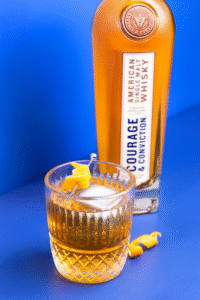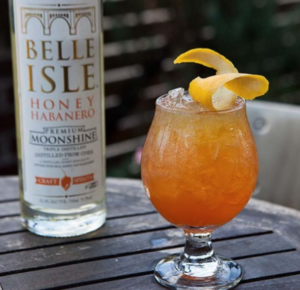So, we’ve talked about Virginia’s top produced spirit: whiskey – we’ve even done a deep dive into bourbon, a whiskey made with at least 51 percent corn and aged in new, charred oak barrels – but we’ve only just alluded to the new and exciting category of American Single Malt. A spirit that has developed and grown in popularity, thanks in large part to Virginia producers.
We’ll get to that, but first – what is it and how is it made?
How to Make
All American Single Malt whiskey starts with a single grain: 100% malted barley. It must also be mashed, distilled and aged in the U.S.; be distilled entirely at one U.S. distillery, stored in oak barrels (used, uncharred new or charred new) with a maximum capacity of 700 L and must be bottled at a minimum 80 proof. These rigorous standards ensure the new category maintains its quality and character from producer to producer.
You might also see some caramel coloring, as long as it’s disclosed on the label, and the term “straight” for those special spirits aged at least two years.
The technical process to make American Single Malt is layered and nuanced, but here are the basic steps:
- Malting: Malted barley is the star. The barley is moistened and allowed to partially germinate, which activates enzymes that convert starches into fermentable sugars. This malting process is halted by drying the grain with heat — sometimes using traditional methods like floor malting or peat smoke, depending on the distiller’s approach.
- Mashing: The malted barley is then ground and mixed with hot water in a mash tun, allowing the sugars to dissolve into the liquid. Since American Single Malt uses 100% malted barley, no additional enzymes or grains are typically added. The mixture becomes a thick, porridge-like mash.
- Fermentation: The sweet liquid (called wort) is transferred to fermentation tanks or washbacks, where yeast is added. Over several days, the yeast consumes the sugars and produces alcohol, resulting in a beer-like liquid (called wash) that reaches about 7–10% ABV. Different yeast strains, fermentation times and even wooden washbacks can influence the final flavor.
- Distillation: American Single Malt is almost always double-distilled in pot stills, following traditional Scottish-style methods. This step refines the alcohol, separates out unwanted compounds, and helps define the final spirit’s texture and flavor. Each distiller controls the “cuts” they keep and discard, which significantly affects the outcome.
- Maturation: By definition, American Single Malt must be aged in oak casks, though the type of oak and prior use (new vs. used barrels) is left to the distiller’s discretion. This is one of the category’s most exciting features: unlike bourbon, which must use new charred oak, American Single Malt offers more flexibility, allowing producers to experiment with used wine, sherry or even local oak barrels.
- Bottling: Once matured to the distiller’s satisfaction, the whiskey is bottled at a minimum of 80 proof. If the spirit comes from a single barrel or is bottled without blending across casks, it’s labeled accordingly — terms like single cask or cask strength often signal special releases that offer a pure snapshot of a distiller’s style.
*If you’re interested in making your own liquid gold, you must follow Virginia codes and regulations. Licenses may be required.
The Virginia Way
There’s no better person to talk about Virginia-made American Single Malt than the director of liquid development at Virginia Distillery Company, Amanda Beckwith. Especially after her latest win taking home the Best in Class (whisky) distinction and Best in Show (overall) at the First Landing Cup competition.
VDC, located in Lovingston, Virginia, was founded to make American Single Malt whisky and is the largest independently owned single malt distillery in the U.S.
“As founding members of the American Single Malt Commission nearly a decade ago, we have been believers in the category since day one,” said Beckwith. “Our vision for single malt was to take the best of old world techniques and show what American innovation and a sense of place could deliver.”

It was important for Beckwith and other champions of American Single Malt to ratify standards and create the category to break away from whiskey in the traditional sense, mostly as U.S. drinkers equate the whiskey with bourbon.
“ASM producers can now move forward with a clear definition and parameters that don’t stifle creativity but rather provide a consistent framework that finally brings American Single Malt into the same recognized space as most other global single malts.”
Virginia Distillery Company created ASM Academy, a free and interactive online course that provides education and awareness for bartenders, distributors and spirits connoisseurs alike. While single malt originated in Scotland, Beckwith says the potential for Virginia is boundless.
“The entire geographic size of Scotland, with its five recognized whisky producing regions, can fit inside the state of Virginia with room to spare,” Beckwith said. “Virginia has an array of microclimates and its conditions for growing barley all the way into aging our whisky are far more dynamic than many single malt production conditions found around the world.
“This intensely impactful environment, coupled with our unique cask partnerships with local breweries, cideries and wineries has allowed Virginia to carve out a distinctive and excitingly innovative style in the American Single Malt scene.”
How to Shop
As the spirit gains momentum, more and more producers in Virginia are crafting high-quality American Single Malt. We recommend you start with this year’s Best in Show, then venture out to try other standouts in the commonwealth.
You have two simple options to purchase a local bottle: Virginia ABC or straight to the source at the distillery. With 400+ stores, you’re likely not far from a Virginia ABC store. If your store doesn’t have what you’re looking for, you can order online and have it shipped to a store of your choice within 7-14 days. If you’re looking for an experience and you want the opportunity to try before you buy, visiting a local distillery is your best bet. Plus, you’ll even find some small-batch products at the distillery that may not be on the shelves or listed with Virginia ABC.
Taking advantage of events or festivals is another great option to sample before committing to the purchase. Distilleries are always dropping new releases or will occasionally have pop-up sales, so if there are brands you know and love, be sure to sign up for newsletter lists or join their club for early access. Speaking of insider knowledge, did you know that September is Virginia Spirits Month? Lucky for you, many Virginia spirits, both in-store at Virginia ABC and at distillery tasting rooms, are offered at 20% off. The perfect time to stock up or try something new.
Finally, simply ask for Virginia-made at your favorite restaurant and try a glass out first. Chat with your bartender or server to determine a cocktail recommendation or which ones are available for a sip. The more we ask for and support local, the more you’ll see Virginia on the menu!
How to Store
Once you have your first sip of Virginia Single Malt, you might just be hooked. Whether your home bar consists of one or two premium bottles or a dozen, here’s what you need to know about proper storage so the last drop is as delectable as the first.
- Keep It Dark and Cool: Limit exposure to sunlight and fluctuations in temperature and humidity, which can damage the label and cork. Keep in mind, if the bottle is open, your whiskey is even more exposed to the elements. The ideal place to store whiskey is a dark, room-temperature cabinet or closet.
- Keep it Upright: Instead of storing on its side (like wine), whiskey should always be kept upright so that unwanted flavors from the cork doesn’t make its way into the high-proof liquid. If you’re holding onto your bottle, turn it on its head every four to six months and let the cork moisten for about ten seconds. (You don’t want the cork to dry out completely and crumble).
- Keep it Closed: After opening, you have to pay close attention to too much “headspace” (empty air) at the top of the bottle, which can lead to oxidation and off-flavors over time. There are products like the Private Preserve that inserts inert gas to fill the space. Or consider purchasing smaller bottles, or clean and save old bottles and decant the whiskey into them. Another option is to wrap the bottle closure tightly with Parafilm to keep out moisture and air.
As your collection grows, check out this guide to maintaining (and showcasing) your most valuable bottles. P.s. don’t forget to inventory as you go along!
How to Enjoy
American Single Malt whiskey is crafted for sipping — meant to be savored, not rushed. Its complex layers of malted barley, oak influence and regional character shine brightest when enjoyed neat. Though it can play well in cocktails, especially spirit-forward classics like the Old Fashioned or Manhattan, American Single Malt is often best appreciated in its pure form.
Its nuanced flavor profile — often showcasing notes of honey, roasted nuts, dark chocolate or smoke — makes it a rich sensory experience.
For food pairings, think of hearty, earthy flavors: aged cheeses, charcuterie, grilled meats, roasted mushrooms or dark chocolate desserts all make great companions. A well-aged American Single Malt can also elevate a simple dish like seared steak or smoked salmon, echoing its subtle complexity.
Whether you’re a longtime whiskey fan or new to the category, American Single Malt rewards slow sipping, thoughtful pairing and an open mind. It’s not just a drink; it’s a discovery in every glass.








